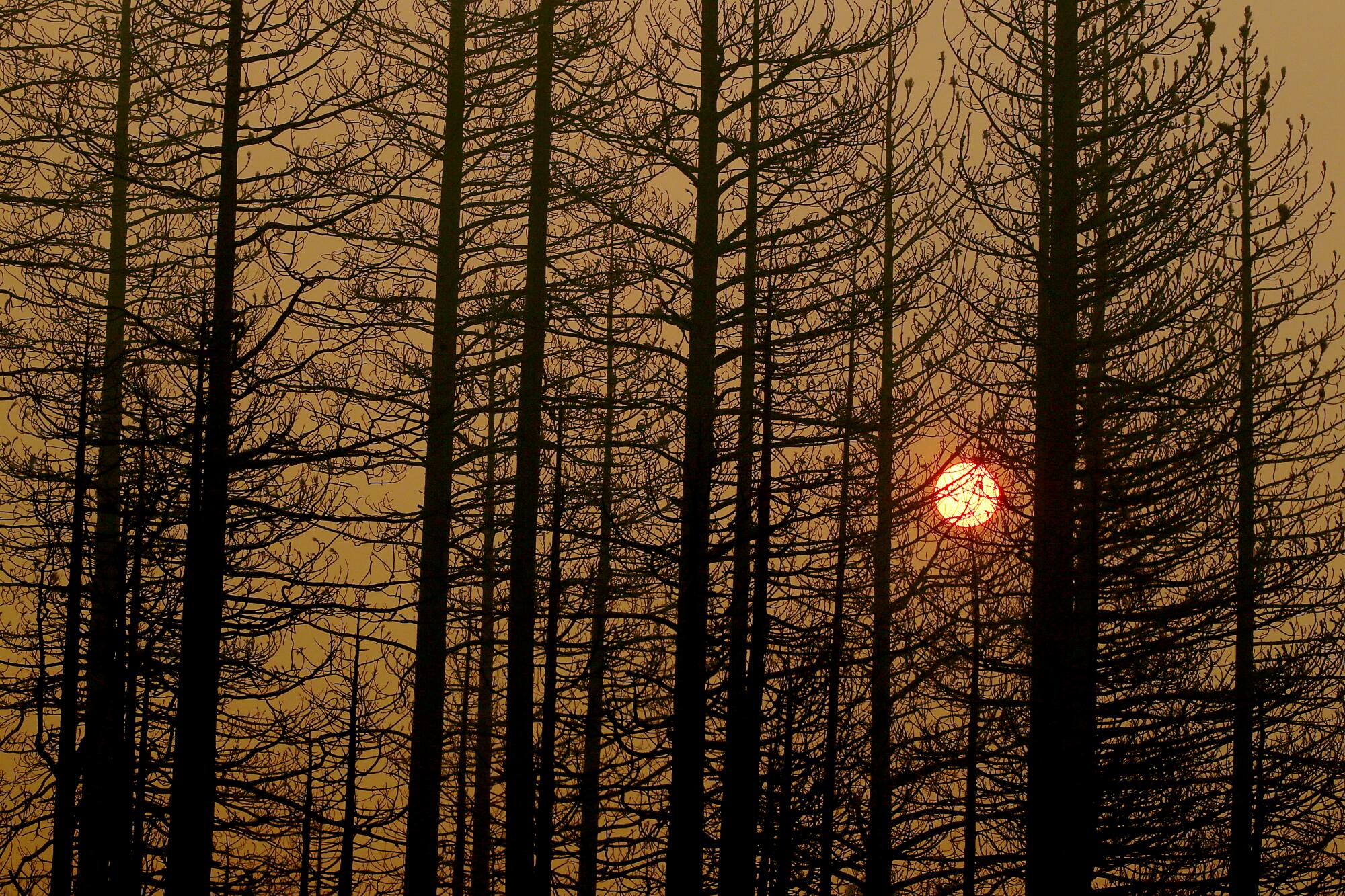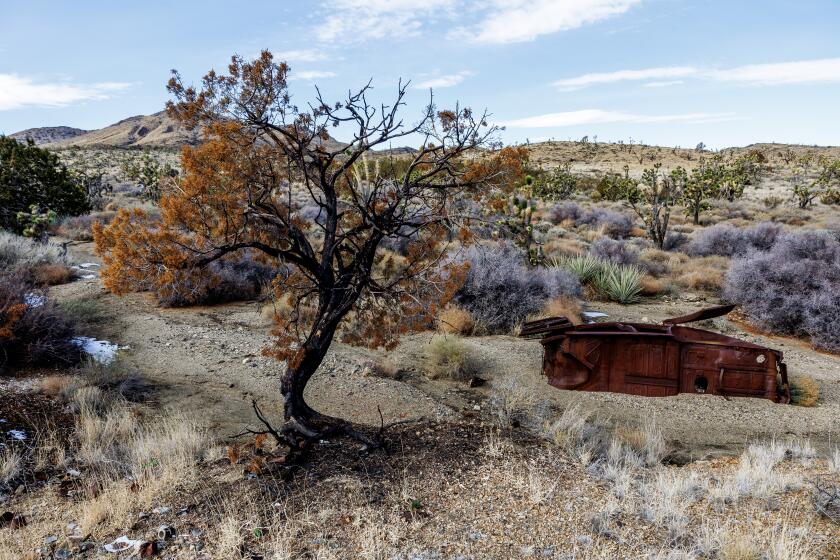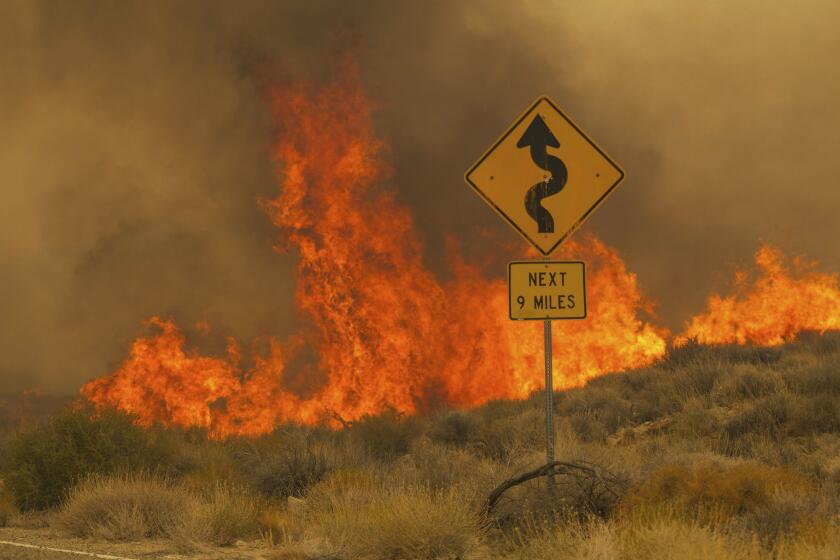
- Share via
As a massive heat dome lingered over the Pacific Northwest three years ago, swaths of North America simmered — and then burned. Wildfires charred more than 18.5 million acres across the continent, with the most land burned in Canada and California.
A new study has revealed the extent to which human-caused climate change intensified the extraordinary event, with researchers theorizing the heat dome was 34% larger and lasted nearly 60% longer than it would have in the absence of global warming. The heat dome, in turn, was associated with up to a third of the area burned in North America that year, according to the study, published in Communications Earth & Environment.
“What happens is you get a stagnated weather pattern — it’s very hot and very dry,” said study author Piyush Jain, research scientist with Natural Resources Canada. “And it dries out all the vegetation and makes whatever is on the ground extremely flammable.”
Aggressive and impactful reporting on climate change, the environment, health and science.
The study adds to a body of literature documenting how the fingerprints of climate change can be detected in events such as heat waves, droughts and wildfires.
Jain was living in Edmonton in late June 2021 when the mercury in North America’s northernmost million-resident city topped 100 degrees. “I was blown away,” he said. “I’d never experienced those temperatures anywhere I’d lived.”
Farther south, the town of Lytton, British Columbia, on June 29 experienced Canada’s hottest recorded temperature, 119 degrees, and was largely destroyed by a wildfire the next day.
The heat dome persisted for a staggering 27 days, from June 18 to July 14, with skyrocketing temperatures across the western United States and Canada killing hundreds of people, resulting in mass die-offs of marine life, devastating crop and timber yields and damaging infrastructure, buckling highways in Washington and melting train power lines in Portland. Over a five-day period in June, locations in seven U.S. states, including California, surpassed all-time maximum temperature records, according to the National Oceanic and Atmospheric Administration.
The heat wave also ratcheted up fire danger, breaking a slew of fire weather records over a broad area and helping to stoke blazes in British Columbia, California, Arizona, Colorado, Utah and Montana. More than 7.9 million acres burned in North America in July alone — at that time, the greatest area in a single month since record-keeping began, according to the study. Smoke traveled across the continent, triggering air quality alerts across much of the East Coast.
Beavers create unburned islands where plants and animals can shelter from megafires, research has confirmed. A movement is afoot to reintroduce the rodents to the state’s waterways.
Jain had previously worked with other researchers to develop a method for evaluating such extreme weather events by looking at anomalies in geopotential heights, which indicate whether there are high or low pressure systems in the upper atmosphere. High pressure systems that persist for a long time tend to correspond with heat waves and increased fire risk, he said. And climate change has contributed to a trend of rising heights, potentially magnifying these events.
In this study, Jain and his colleagues analyzed what the heat dome would have looked like without this trend. They estimated that it would have been 34% smaller, 59% shorter and had a 6% lower magnitude.
The researchers also found strong links between the extreme heat and wildfire activity in 2021. That year, 21% of the land burned in North America was scorched by fires that started during and within the heat dome, with that figure rising to 34% when taking into account fires that started within 10 days, the researchers found.
The size of the heat dome made it particularly troubling because it resulted in what the study authors called widespread synchronous burning, with many disparate areas igniting at the same time. That posed a challenge to fire agencies because they tend to ask for help from other places when they don’t have enough resources locally.
“If other areas are also experiencing the same resource strain, you can reach a bottleneck at some point,” Jain said.
Record heat. Raging fires. What are the solutions?
Get Boiling Point, our newsletter about climate change, the environment and building a more sustainable California.
You may occasionally receive promotional content from the Los Angeles Times.
When there aren’t enough resources to attack fires when they first start, blazes that might have otherwise been snuffed out when they were small grow large and difficult to contain, resulting in the need for yet more resources, said John Abatzoglou, a professor of climatology at UC Merced who also worked on the study. If this type of synchronous activity persists in future years, it could force fire managers to reevaluate the reliability of resource-sharing arrangements, he said.
The study did not look specifically at how the heat dome, which extended into Northern California, affected the state’s fire season. That summer, the 963,000-acre Dixie fire, which started July 13, became the first to burn from one side of the Sierra Nevada to the other, followed in short order by the 221,000-acre Caldor fire.
In general, it’s difficult to completely attribute a fire to any individual factor, because flames are often fueled by a complex interplay of conditions — anything from overstocked forests to wind, Abatzoglou said. Still, in 2021, California had its hottest June to July in the observational period, and researchers have established a strong relationship between warm, dry summers and area burned in the state’s forests, he said.
“It’s obviously difficult to say how much the heat dome itself was responsible for those fires,” Abatzoglou said. “But based on the hellaciously warm temperatures in that month, the significant heat wave events, we can say that those conditions certainly helped enable fuels to become incredibly available and provided less resistance to fire, once a fire started.”
Last year’s York fire has sparked discussion about how to deal with conflagrations in the Mojave National Preserve.
The findings add to the understanding of how climate change can affect extreme weather events — and the potential role these events can play in fire activity.
“This is the latest in a growing body of evidence about the causes of wildfire conditions globally but in particular in western North America,” said Noah Diffenbaugh, a climate scientist at Stanford University who was not involved in the study. “I think this, in particular, is an advance in linking record-breaking fire weather conditions to the specific atmospheric conditions for a specific event.”
It’s important to untangle climate change’s influence on extreme weather events like the heat dome, which are increasing in frequency and intensity, Diffenbaugh said. A lot of infrastructure and risk management systems are built around assumptions about how these events will play out, so if that changes, those systems become stressed, he said.
“The linking, through this careful analysis, of the contribution of climate change to the record-breaking fire weather conditions associated with the heat dome is a really great example of the kind of research that we need to accurately quantify the risk of climate change,” Diffenbaugh said. “Both the climate change that we’re already living with, and the climate change that we can expect to happen in the future, even if the world’s ambitious global warming goals are achieved.”
Forecasters are anticipating a late start to California’s wildfire season, but they can’t yet say whether it will be severe.
Studies that attempt to quantify the role of climate change in individual events can also help calculate the health costs and financial toll of planetary heating from carbon emissions, which have been cited by a growing number of lawsuits seeking damages.
Learning under what conditions these events occur can also help people understand how a warming climate can lead to more extremes in the future, Jain said.
And all indications suggest that that future is approaching quickly. Since the study was written, Canada’s 2021 wildfire season was dwarfed by that of 2023, which saw more than 45 million acres burn. Jain now has a preprint examining how heat waves played a role. Although there was no single event as extreme as 2021’s heat dome, some regions of Canada saw many more heat events than on average, he said.
“So 2023 was not dominated by a single event, but when you looked overall at the number of these events that occurred, it was a very extreme year in terms of heat waves,” he said. “And, of course, 2023 was the warmest year on record globally.”











